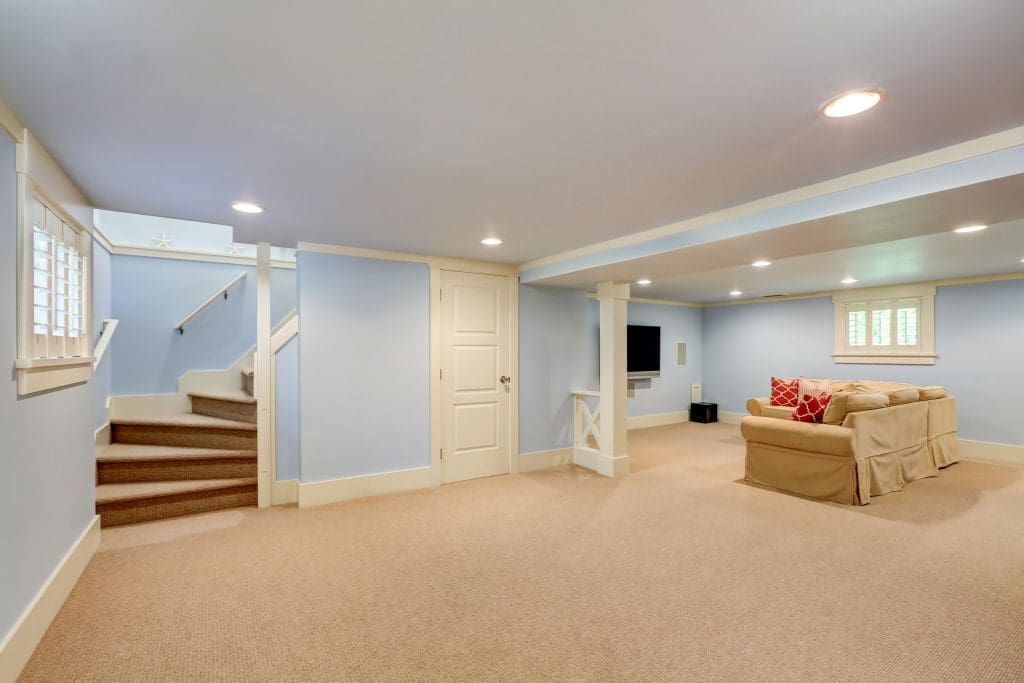Basement Finishing & Remodeling
 A finished basement is a great addition to any home and can truly add an entirely new living space, a place for your next “mancave”, an extra office, a rental space to create some cashflow, an area for your children and much more!
A finished basement is a great addition to any home and can truly add an entirely new living space, a place for your next “mancave”, an extra office, a rental space to create some cashflow, an area for your children and much more!
According to the team at Realty Improvement, there are a number of options for your basement renovations and in many ways, it can be the most fun, and one of the most creative outlets for anyone who has either been in the home renovations space for some time, or even someone who is just getting into things. However, in some instances, if you are thinking to add more than just some minor things, like a bathroom, kitchen or more – the team at Realty Improvement will definitely recommend the assistance of an experienced professional who is knowledgeable in renovations and basement work in general.
Some Helpful Tips for Your Basement Finishing
- Keep Things Dry & Weather Proofing
Check for any water issues in your basement before beginning the planning process. Obvious signs are pools of water or drips coming through the below-grade walls. Check outside to make sure the ground is graded away from your foundation. Also look for cracks in your foundation walls and repair that damage if necessary. Often, basements susceptible to leaks and cracks, that can cause issues like flooding, water penetration and much more. - Keep Things Up to Code
Especially when it comes to basements, code violations are extremely common and can often lead to thousands in fines and fees. After you’ve taken care of any moisture problems and have come up with your plan, it’s time to check with your local municipality to see if you’ll be required to get any permits. This is particularly important if you’re planning plumbing and electrical work, which may have to be inspected. - Consider Fasteners
Basement walls and floors are generally some sort of masonry, cement, block or brick, and a regular old nail or screw isn’t going to cut it when attaching framing. You’ll need to get the proper fastener and possibly anchors for your wall type. In some cases, you may need to rent a powder-actuated fastener, sometimes referred to as a shotgun fastener. These are similar to a shotgun in that they use a charge to fire a fastener into concrete. - Add a Vapor Barrier
Even after taking care of any moisture issues, your basement can become a damp place. You’ll need to add a vapor barrier to both the walls and floors prior to framing and finishing off these surfaces. It’s a good idea to lay down a vapor barrier for a day or two, then check underneath to see if and how much moisture may be coming through before continuing. - Offset Space Can Definitely Add to Your Basement
Despite all efforts, even with a vapor barrier, moisture can still be an issue. Create a slight offset from the outside wall by adding thin slats of wood or metal called furring strips. These strips can also be used to help level out a wall that may be “wavy” to create a flat surface for adding framing. - Insulation is Important – Keep the Cold Out & The Warmth In
Insulation will not only help control the temperature inside your basement, it may also add another layer of moisture control, as well as help dampen sound from the outside. Choose an insulation that includes a vapor barrier on both sides. Other options include a spray foam insulation. Be sure to check code requirements for this type. - Dropping the Ceilings Can Provide Easy Access
A drop, or suspended, ceiling offers a way to both conceal and provide access to electrical and plumbing lines via the removable tiles. You may have a preconceived notion that such a ceiling will look more like an office than a home, but there are plenty of attractive options available. These ceilings will reduce the amount of overhead space available, so keep that in mind when planning. -
Recessed Lighting Can Add Value
Recessed lighting in a basement is a good option, because they won’t take up valuable overhead space that a light fixture would. Plus, it’s easy to install with a drop ceiling and it makes for quality looking lighting that can raise your property value. - Add Some Warmth at the Baseboards
Warm air rises, so it makes sense to install heating vents at floor level. Baseboard heating is a good option, but make sure it makes sense for your plan and is easy to tie into your existing HVAC system. For a finished space, you want to make sure you’re not relying on space heaters, so plan carefully. - The Utility Room is Not for Finishing
Keep the space housing an HVAC unit or units and water heaters clear, open, and unfinished. These spaces have specific code requirements for spacing and framing, plus you’ll need access for inspection and/or repairs. You may be tempted to finish off this area, but keep it simple to avoid problems later.
For more information on your next basement finishing project, or home renovations, be sure to contact Realty Improvement today.